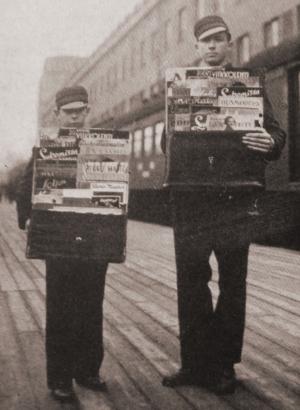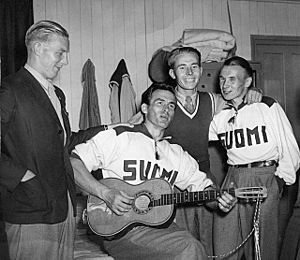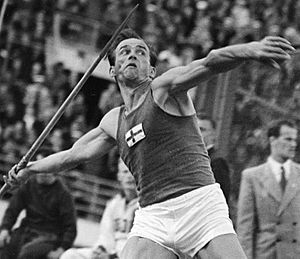Tapio Rautavaara facts for kids

Rautavaara at the 1937 Workers' Olympiads in Antwerp
|
|||||||||||||||||||||||||||||
| Personal information | |||||||||||||||||||||||||||||
|---|---|---|---|---|---|---|---|---|---|---|---|---|---|---|---|---|---|---|---|---|---|---|---|---|---|---|---|---|---|
| Born | 8 March 1915 Pirkkala, Finland |
||||||||||||||||||||||||||||
| Died | 25 September 1979 (aged 64) Helsinki, Finland |
||||||||||||||||||||||||||||
| Height | 189 cm | ||||||||||||||||||||||||||||
| Weight | 85–87 kg | ||||||||||||||||||||||||||||
| Sport | |||||||||||||||||||||||||||||
| Sport | Athletics, archery | ||||||||||||||||||||||||||||
| Event(s) | Javelin throw | ||||||||||||||||||||||||||||
| Club | Oulunkylän Tähti, Helsinki | ||||||||||||||||||||||||||||
| Achievements and titles | |||||||||||||||||||||||||||||
| Personal best(s) | 75.47 m (1945) | ||||||||||||||||||||||||||||
|
Medal record
|
|||||||||||||||||||||||||||||
Kaj Tapio Rautavaara (born March 8, 1915 – died September 25, 1979) was a famous Finnish person. He was a talented singer with a deep voice, an amazing athlete, and a film actor. He was known for his many skills!
Contents
Tapio Rautavaara's Early Life
Tapio Rautavaara was born in a place called Pirkkala, which is now part of Nokia. His mother, Hilda Rautavaara, moved to Helsinki when he was very young. Tapio's father was not often around and later left the family.
In 1921, Tapio and his mother moved to Tampere. Tapio sometimes had disagreements with his teachers because of his family's background. He earned money by selling newspapers for workers at the Finlayson textile factory. Four years later, they moved back to Oulunkylä, a suburb of Helsinki, where Tapio lived for the rest of his life.
In the late 1920s, Tapio joined a local sports club called Oulunkylän Tähti. There, he started practicing athletics. Tapio finished elementary school but did not continue his formal education. Before the Winter War began in 1939, he worked many jobs. He was a newspaper seller, a road worker, a lumberjack, and a storeman at a mill. He also served in the Finnish Navy in the mid-1930s.
Tapio's Time in the War
When the Winter War started, the Navy was not very busy. So, Tapio was allowed to keep working at the mill. But when the Continuation War began, he was called to the army. He spent the first year of the war on the front line.
In the summer of 1942, Tapio was moved to a special group that entertained soldiers. For two years, he worked as a radio journalist at Aunus Radio, which was near the front. During this time, he became well-known to the soldiers. In the summer of 1944, the Finnish army had to retreat, and Tapio's radio career ended.
Tapio's Sports Achievements
Tapio Rautavaara was a very skilled javelin thrower and archer. In 1937, he competed in the Workers' Olympiads in Antwerp. He came in second place in the javelin throw.
After World War II, Tapio won many awards.
- In 1946, he won a bronze medal at the European Championships.
- In 1948, he won a gold medal at the Olympic Games.
- He also won five national titles in Finland between 1944 and 1949.
- In 1950, he placed fifth at the European Championships.
In archery, Tapio also achieved great success.
- He won a team gold medal at the 1958 World Championships.
- He won a national title in Finland in 1955.
Tapio's Music and Acting Career
After the war, Tapio met Reino Helismaa, who wrote songs. Together, they created Tapio's first hit song, Reissumies ja kissa (The Traveler and the Cat). Later, composer Toivo Kärki joined their team. For the next ten years, they made many popular songs. Tapio also wrote and composed many of his own songs.
He earned "gold records" for three of his songs:
- Isoisän olkihattu (Grandpa's Strawhat)
- Vain merimies voi tietää (Only a Sailor Could Know)
- Häävalssi (The Wedding Waltz)
Tapio, Reino Helismaa, and Esa Pakarinen toured Finland together in the late 1940s and early 1950s. Even after they stopped touring together, Tapio continued to record songs with Helismaa's lyrics until Helismaa passed away in 1965. By the time Tapio died in 1979, he had recorded about 300 songs!
Tapio Rautavaara became one of the most loved singers in Finland. Some of his famous songs include:
- Isoisän olkihattu (Grandfather's Straw Hat)
- Reppu ja reissumies (The Backpack and the Traveler)
- Korttipakka (The Deck of Cards)
- Kulkuri ja joutsen (The Tramp and the Swan)
- Sininen uni (Blue Dream)
Tapio also starred in many Finnish films. There were even talks about him possibly playing Tarzan in movies after Johnny Weissmuller stopped playing the role!
Later Years and Legacy
Tapio Rautavaara was most popular in the 1950s and early 1960s. After that, other types of music became more popular, and television also changed things. However, he kept performing regularly until he passed away. In the 1970s, he often performed for smaller audiences, like in department stores.
Tapio Rautavaara's Passing
On September 25, 1979, Tapio Rautavaara was at a swimming center in Vantaa. He was taking photos for a book called Kultaa, kunniaa, kyyneleitä (which means "Gold, glory, tears"). After using the sauna, he slipped and hit his head. He was taken to a nearby health center, but his injury was not thought to be serious. His head was bandaged, and he was sent home.
That night, he passed away at his home in Oulunkylä because of a serious head injury. He was buried in the Malmi Cemetery in Helsinki.
Memorials and Tributes
A special memorial statue, called Kulkurin uni ("A Vagabond's Dream"), was made in Tapio's memory. It is located in the market square in Oulunkylä, where he lived for most of his life.
There have also been films and plays about Tapio's life:
- Peter von Bagh made a TV documentary about him called Tapsa in 1979.
- Timo Koivusalo made a film called Kulkuri ja joutsen in 1999, based on Tapio's tours.
- In 2007, a play called Sininen uni (The Blue Dream) about his life was performed.
Influence on Other Artists
Tapio Rautavaara has inspired many other musicians. For example, Ville Valo, the lead singer of the Finnish rock band HIM, has said that Tapio Rautavaara is his biggest idol in Finnish music.
Famous Recordings by Tapio Rautavaara
Here are some of Tapio Rautavaara's most well-known songs:
- Päivänsäde ja menninkäinen (The Sunbeam and the Troll), 1949/1965
- Reissumies ja kissa (The Tramp and the Cat), 1949
- Kulkuri ja joutsen (The Tramp and the Swan), 1950
- Isoisän olkihattu (Grandfathers Strawhat), 1951/1963
- Sininen uni (Blue Dream), 1952
- Juokse sinä humma (Run, Horse), 1953
- Yölinjalla, (I Walk the Line), 1962
- Tuopin jäljet (The Marks of My Tankard), 1963
- En päivääkään vaihtaisi pois (I Wouldn't Change A Day), 1979
Tapio Rautavaara's Films
Tapio Rautavaara acted in many films. Here are some of them:
- Vain sinulle (Only for you) (1945)
- Synnin jäljet (Marks of sin) (1946)
- Kuudes käsky (Sixth order) (1947)
- Kultamitalivaimo (1947)
- Sinut minä tahdon (I Want You) (1949)
- Aila, Pohjolan tytär (Aila, Daughter of North) (1951)
- Rion yö (Night of Rio) (1951)
- Salakuljettajan laulu (Song of smuggler) (1952)
- Pekka Puupää (1953)
- 2 hauskaa vekkulia (2 funny guys) (1953)
- Me tulemme taas (We are coming again) (1953)
- We Come During Spring (1953)
- Villi Pohjola (Wild North) (1955)
- X-Paroni (1964)
- Anna (1970)
See also
 In Spanish: Tapio Rautavaara para niños
In Spanish: Tapio Rautavaara para niños





